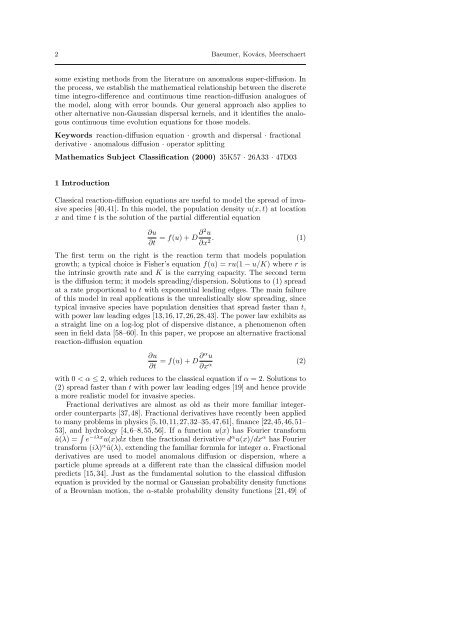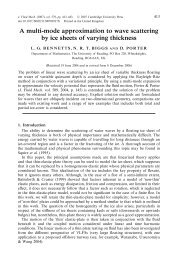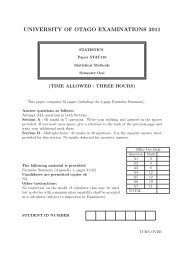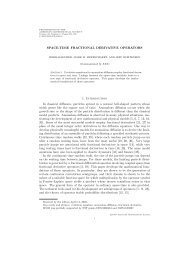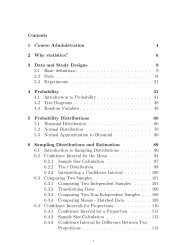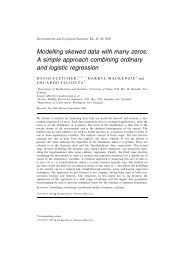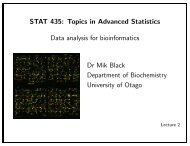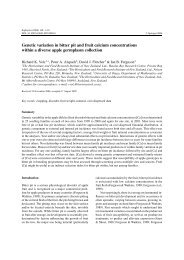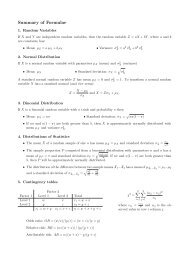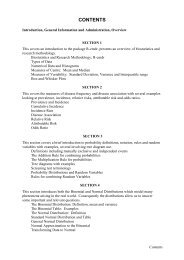Fractional reaction-diffusion equation for species ... - ResearchGate
Fractional reaction-diffusion equation for species ... - ResearchGate
Fractional reaction-diffusion equation for species ... - ResearchGate
Create successful ePaper yourself
Turn your PDF publications into a flip-book with our unique Google optimized e-Paper software.
2 Baeumer, Kovács, Meerschaert<br />
some existing methods from the literature on anomalous super-<strong>diffusion</strong>. In<br />
the process, we establish the mathematical relationship between the discrete<br />
time integro-difference and continuous time <strong>reaction</strong>-<strong>diffusion</strong> analogues of<br />
the model, along with error bounds. Our general approach also applies to<br />
other alternative non-Gaussian dispersal kernels, and it identifies the analogous<br />
continuous time evolution <strong>equation</strong>s <strong>for</strong> those models.<br />
Keywords <strong>reaction</strong>-<strong>diffusion</strong> <strong>equation</strong> · growth and dispersal · fractional<br />
derivative · anomalous <strong>diffusion</strong> · operator splitting<br />
Mathematics Subject Classification (2000) 35K57 · 26A33 · 47D03<br />
1 Introduction<br />
Classical <strong>reaction</strong>-<strong>diffusion</strong> <strong>equation</strong>s are useful to model the spread of invasive<br />
<strong>species</strong> [40,41]. In this model, the population density u(x, t) at location<br />
x and time t is the solution of the partial differential <strong>equation</strong><br />
∂u<br />
∂t = f(u) + D ∂2 u<br />
∂x 2 . (1)<br />
The first term on the right is the <strong>reaction</strong> term that models population<br />
growth; a typical choice is Fisher’s <strong>equation</strong> f(u) = ru(1 − u/K) where r is<br />
the intrinsic growth rate and K is the carrying capacity. The second term<br />
is the <strong>diffusion</strong> term; it models spreading/dispersion. Solutions to (1) spread<br />
at a rate proportional to t with exponential leading edges. The main failure<br />
of this model in real applications is the unrealistically slow spreading, since<br />
typical invasive <strong>species</strong> have population densities that spread faster than t,<br />
with power law leading edges [13,16,17,26,28,43]. The power law exhibits as<br />
a straight line on a log-log plot of dispersive distance, a phenomenon often<br />
seen in field data [58–60]. In this paper, we propose an alternative fractional<br />
<strong>reaction</strong>-<strong>diffusion</strong> <strong>equation</strong><br />
∂u<br />
∂t = f(u) + D ∂α u<br />
∂x α (2)<br />
with 0 < α ≤ 2, which reduces to the classical <strong>equation</strong> if α = 2. Solutions to<br />
(2) spread faster than t with power law leading edges [19] and hence provide<br />
a more realistic model <strong>for</strong> invasive <strong>species</strong>.<br />
<strong>Fractional</strong> derivatives are almost as old as their more familiar integerorder<br />
counterparts [37,48]. <strong>Fractional</strong> derivatives have recently been applied<br />
to many problems in physics [5,10,11,27,32–35,47,61], finance [22,45,46,51–<br />
53], and hydrology [4,6–8,55,56]. If a function u(x) has Fourier trans<strong>for</strong>m<br />
û(λ) = ∫ e −iλx u(x)dx then the fractional derivative d α u(x)/dx α has Fourier<br />
trans<strong>for</strong>m (iλ) α û(λ), extending the familiar <strong>for</strong>mula <strong>for</strong> integer α. <strong>Fractional</strong><br />
derivatives are used to model anomalous <strong>diffusion</strong> or dispersion, where a<br />
particle plume spreads at a different rate than the classical <strong>diffusion</strong> model<br />
predicts [15,34]. Just as the fundamental solution to the classical <strong>diffusion</strong><br />
<strong>equation</strong> is provided by the normal or Gaussian probability density functions<br />
of a Brownian motion, the α-stable probability density functions [21,49] of


